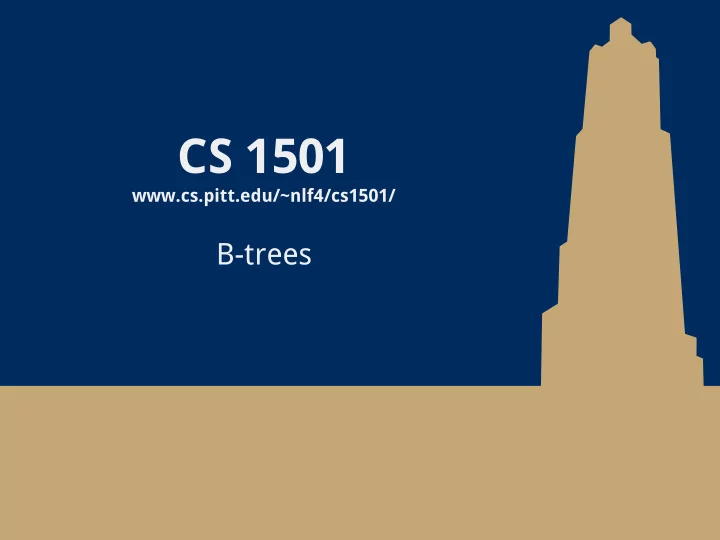

CS 1501 www.cs.pitt.edu/~nlf4/cs1501/ B-trees
The problem We’ve discussed several approaches to search through a set ● of keys and retrieve a value Several implementations of a symbol table ○ All of them assumed we were storing the keys/values (the ● symbol table) in memory What if data needs to be stored on disk? ● ○ What should we do differently? 2
Consider the following example You’re writing software that will be used to store records of ● online store transactions, each with a unique ID ○ E.g., vinyl album sales ● You’ll want to store these transaction records on disk You expect a large volume of transaction records ○ You want the transaction records stored in non-volatile ○ memory How can you still efficiently search for a given transaction by ● its ID? 3
Disk storage Data stored on disk is grouped into blocks ● ○ Typically of size 4KB ● I/O to the disk is performed at the block level To read a file from disk, the OS will fetch all of the blocks ● that store some portion of that file, and read the data from each block 4
B-trees Operates similarly to a binary search tree, but not limited to ● a branching factor of 2 ● The order of a B-tree determines the max branching factor Invariants for an order M B-tree: ○ Nodes have a max of M children ■ Interior nodes have at min of ⌈ M/2 ⌉ children ■ Nodes that are not the root or leaves ● Corollary: all interior nodes must be at least half full ● ■ Root has at least two children if it is not a leaf node ■ Non-leaf nodes with k children have k-1 keys stored ■ All leaves appear on the same level 5
Inserting into a B-tree Start with a single node ● ● Add keys until the node fills I.e., contains M-1 keys, has M children ○ In adding the Mth key, split the node in two ● ○ Pull one key up to the parent node ■ Potentially creating a new parent node 6
OK, so how does this help us store transaction records? See how to store IDs as keys, but what about full records of ● a sale transaction ID, customer info, price, item purchased, how many ○ purchased, etc. 7
B Tree analysis Runtime ● Search? ○ Insert? ○ ● To maintain invariants, tree must be self-balancing 8
Deleting from a B-tree Find and delete the key ● ○ If the key is not in a leaf node, you need to find a replacement … ● Rebalance the tree ○ Is there a sibling node with more than minimum keys? ■ If so rotate right/left accordingly ○ If not, need to merge with the left or right sibling 9
Wait, what does this have to do with disks?? 10
What if we want to read all records? How long will it take us to find all the disk blocks containing ● records? Is there a better way? ● 11
B+trees Maintain a copy of all keys in the leaves of the tree ● ● Create a linked-list out of the leaf nodes of the tree 12
B-/+tree discrepancies Defining order ● ○ Here M is the max number of children ○ Elsewhere, could be the min number of keys ■ Min was the original notation, but is ambiguous ● Where to go to follow = keys ○ Some implementations have left link point to keys <=, and right point to keys strictly > ○ Others have left point to keys strictly <, and right link point to keys >= 13
Note: The variant of B-trees presented here differs slightly from ● that presented in the book B+trees are not discussed in the book ● 14
Realistic application of this solution Typically, you’ll store such records in a database ● ○ But how does the database store records? ■ IBM DB2, Informix, Microsoft SQL Server, Oracle 8, Sybase ASE, and SQLite all use B+trees to store tables indexes ● Other applications? ○ NTFS, ReiserFS, NSS, XFS, JFS, ReFS, and BFS all use B+trees for metadata indexing 15
Recommend
More recommend